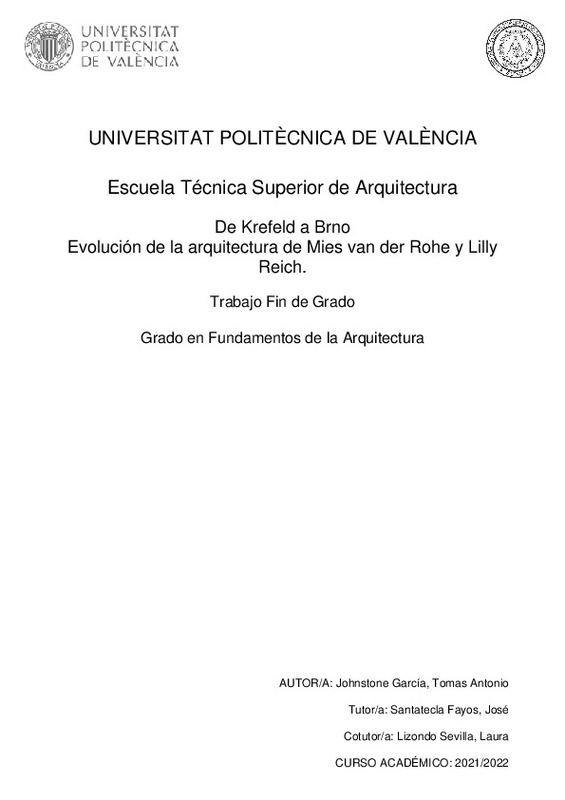|
Resumen:
|
[ES] Tras la Primera Guerra Mundial el pensamiento de Mies van der Rohe gira hacia un compromiso inequívoco con la modernidad. No obstante, la arquitectura que construye en este momento no logra plasmar al completo su ...[+]
[ES] Tras la Primera Guerra Mundial el pensamiento de Mies van der Rohe gira hacia un compromiso inequívoco con la modernidad. No obstante, la arquitectura que construye en este momento no logra plasmar al completo su teoría.
Es en 1926, año en que comienza a colaborar con la responsable de las exposiciones del Werkbund, Lilly Reich, cuando se aprecian explícitamente los primeros signos de modernidad. Éstos son más que evidentes en el proyecto del Pabellón Alemán para la Exposición Internacional de Barcelona de 1929 y la Casa Tugendhat, realizada en Brno entre 1928 y 1930.
Hasta ese momento, Mies van der Rohe y Lilly Reich proyectan y diseñan una serie de exposiciones y proyectos residenciales, siendo de especial interés los proyectos para la Casa Esters y la Casa Lange, construidos tan solo un año antes que la Casa Tugendhat. Del estudio de estas viviendas se observa cómo reúnen características propias de la tradición constructiva alemana pero en conjunción con los nuevos principios arquitectónicos que, junto a Lilly Reich, Mies estaba desarrollando.
Es por ello que el presente Trabajo Final de Grado tiene por objeto analizar la Casa Lange y la Casa Esters para su posterior comparación con la Casa Tugendhat, a fin de esclarecer cómo Ludwig Mies van der Rohe y Lilly Reich evolucionan su modo de hacer arquitectura. De Krefeld a Brno...
[-]
[EN] After the First World War, Mies van der Rohe’s thinking shifted towards an unequivocal
commitment to modernity. However, the architecture he was building at this time failed
to fully reflect his theory.
It was in ...[+]
[EN] After the First World War, Mies van der Rohe’s thinking shifted towards an unequivocal
commitment to modernity. However, the architecture he was building at this time failed
to fully reflect his theory.
It was in 1926, when he began to collaborate with Lilly Reich, who was in charge of
Werkbund’s exhibitions, that the first signs of modernity became explicitly visible. These
were more than evident in the design of the German Pavilion for the 1929 Barcelona In-
ternational Exposition and the Tugendhat House, built in Brno between 1928 and 1930.
Up to this point, Mies van der Rohe and Lilly Reich planned and designed a series of
exhibitions and residential projects. Of particular interest are the projects for the Esters
House and the Lange House, built only a year before the Tugendhat House. Through the
study of these houses it is shown how they combine the characteristics of the german
building tradition with the new architectural principles that Mies, together with Lilly Reich,
was developing.
For this reason, the aim of this Final Degree Project is to analyse the Lange House and
the Esters House for its later comparison with the Tugendhat House, in order to clarify
how Ludwig Mies van der Rohe and Lilly Reich evolved their way of doing architecture.
From Krefeld to Brno...
[-]
|







